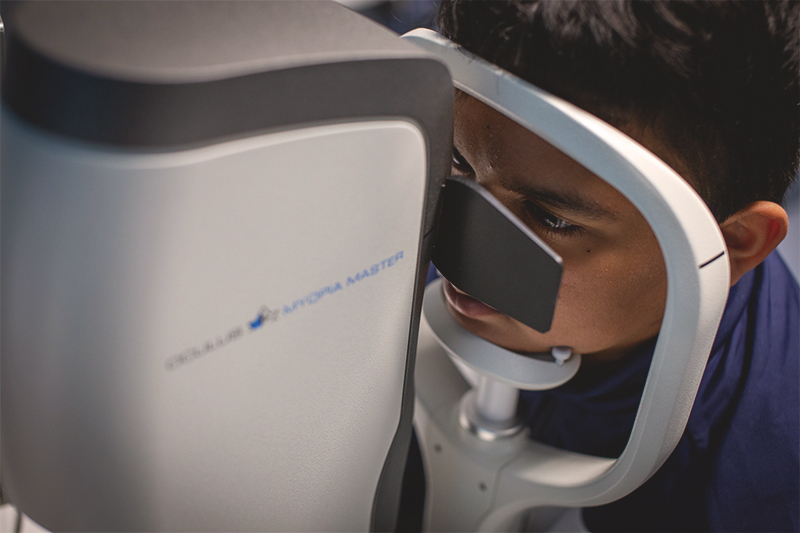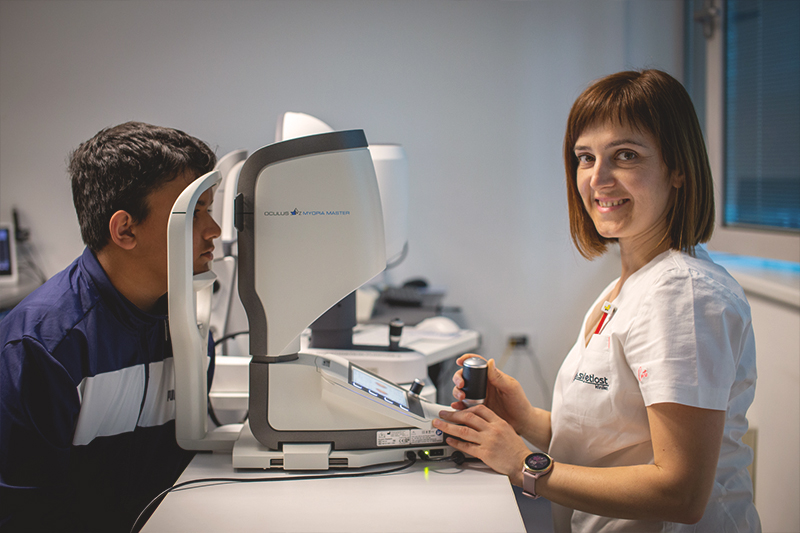Myopia Control Oculus the newest device that combines all the information needed to monitor this condition.
Over the last 20 years, myopia (short-sightedness) has doubled with an estimation of half the world's population diagnosed with myopia by the end of 2050.
Some predictions estimate of 70% of those who will be diagnosed with myopia it will be with accompanying pathology.
Myopia affects the quality of life and can be a limiting factor in learning and career trajectory, consequently an economic burden for the individual and our society. With the current scientific knowledge progression of myopia can be slowed during childhood. It comes as no surprise how more and more attention is given to the control of myopia.
A myopic eye is longer than a standard and is more responsive to degenerative changes because the structures inside the eye are more stretched and thinner than they should be.
Therefore during childhood, it is crucial to minimize excessive eye growth to a minimum. As a rule, each millimetre of additional eye length carries an additional 2.7 diopters with it. Short-sighted people, depending to the degree of short-sightedness, are at greater risk of earlier cataracts, retinal detachment and yellow spot disease than their peers. While small myopes ( -1.0 to -3.5) are 2-3 times at higher risk for these diseases, myopia over -6.0 carries a 5x higher risk of cataract formation, 21x higher risk of retinal detachment and as much as 41x higher risk of myopic macula disease. These patients also have a higher risk of developing glaucoma and certain types of strabismus.
Many researches are going on around the world to learn about the best methods that would help reduce excessive eye growth in childhood. Today, there are some methods that are prooved to be effective and are officialy recommended by leading ophthalmological and paediatric societies (World Society of Pediatric Ophthalmology and Strabismus, American Association for Peadiatric Ophthalmology and Strabismus). These methods include some special type of glasses, contact lenses or eye drops as well as recomendations for the life style and habits.
It has been proven that spending time in daylight can slow myopia progression, so at least 2 hours a day outside is recommended. This recommendation is of greatest importance during the preschool age when the child's eye is very sensitive for myopia growth . Exposure to daylight causes an increase in secretion of substance called dopamine, which is proven to reduces eye growth thus preventing an increase in myopia.
During the COVID pandemic, children started to spend more time indoors, under artificial lighting, and less time aoutdoors.
Another habit that has to be reduced is the time spent on screen ( mobile phones, tablets, televisions...). In general, the number of hours spent working at close range is related to the increase in development and growth of short-sightedness, and the screens appear to further worsen the prognosis of the eye growth. Work in low light settings should also be avoided and instead provided in areas where the child is staying with good lighting. These behavioral changes are recommended to all children and special care shoud be taken for children whose parents who are short-sighted, as they are at higher risk of developing short-sightedness on their own.
When myopia appears, we have eye drops and specially designed glasses and lenses available.
Through numerous studies, Atropine drops have been shown to reduce myopia progression when used in very small concentrations of 0.01%, 0.02%, 0.05%.
It has been shown that ordinary glasses with the same diopter in all segments overcorrect the peripheral part of the eye that is naturaly curved, and that this most likely stimulates additional eye growth in length. This myopia control designed lenses are designed with withprescribed diopter in the center which enables the child to have a goodd vision and reduced refractive power towards perifery which is addapted to the natural curvature of the eye so that this part of the eye is not overcorrected. Today we have seeral types of thi kind of lenses with design that varies from one manufacturer to another. Some manufacturers achieve the desired design using the so-called D.I.M.S.lens ( defocus-incorporated multisegment spectacle lenses) by incorporating into the zone on the middle periphery of the lens numerous segments with the addition of +3.50 diopters, while others achieve this with H.A.L. lens( Highly Aspherical Lenslet Spectacle Lenses) which are incorporated into the same zone of highly aspherical lens segments. Contact lenses for myopia control have a similar design, with a distance centre, while there are zones with a smaller diopter towards the periphery. In some cases, children are given special lenses overnight (Ortho K) that re-modulate the surface of the cornea, so during the day the child does not have to wear glasses because the effect that lenses works throughout the day.
Now, for even better myopia control, at Svjetlost Eye Clinic we have the newest device that combines all the information needed to monitor and controll myopia progression in children.

Myopia Control Oculus is a diagnostic device that simultaneously records and combines all important factors such as eye length, measure surface of the cornea and objective refraction, which is of great importance for a child's comfort when visiting a doctor because it does not require measuring on multiple devices . The obtained values are compared with the normative for childs age. A great benefit of this device is posibility of prediction and calculation of the final myopic refractive error for each child if no treatment is performed . As soon as the abnormal trend of eye growth is discovered we have possibility to start treatment and better chances to slow myopia progression. After the assessment is performed Myopia master has possibility to give customized recommendations regarding the risk factors for myopia progression.
Some predictions estimate of 70% of those who will be diagnosed with myopia it will be with accompanying pathology.
Myopia affects the quality of life and can be a limiting factor in learning and career trajectory, consequently an economic burden for the individual and our society. With the current scientific knowledge progression of myopia can be slowed during childhood. It comes as no surprise how more and more attention is given to the control of myopia.
A myopic eye is longer than a standard and is more responsive to degenerative changes because the structures inside the eye are more stretched and thinner than they should be.
Therefore during childhood, it is crucial to minimize excessive eye growth to a minimum. As a rule, each millimetre of additional eye length carries an additional 2.7 diopters with it. Short-sighted people, depending to the degree of short-sightedness, are at greater risk of earlier cataracts, retinal detachment and yellow spot disease than their peers. While small myopes ( -1.0 to -3.5) are 2-3 times at higher risk for these diseases, myopia over -6.0 carries a 5x higher risk of cataract formation, 21x higher risk of retinal detachment and as much as 41x higher risk of myopic macula disease. These patients also have a higher risk of developing glaucoma and certain types of strabismus.
Many researches are going on around the world to learn about the best methods that would help reduce excessive eye growth in childhood. Today, there are some methods that are prooved to be effective and are officialy recommended by leading ophthalmological and paediatric societies (World Society of Pediatric Ophthalmology and Strabismus, American Association for Peadiatric Ophthalmology and Strabismus). These methods include some special type of glasses, contact lenses or eye drops as well as recomendations for the life style and habits.
It has been proven that spending time in daylight can slow myopia progression, so at least 2 hours a day outside is recommended. This recommendation is of greatest importance during the preschool age when the child's eye is very sensitive for myopia growth . Exposure to daylight causes an increase in secretion of substance called dopamine, which is proven to reduces eye growth thus preventing an increase in myopia.
During the COVID pandemic, children started to spend more time indoors, under artificial lighting, and less time aoutdoors.
Another habit that has to be reduced is the time spent on screen ( mobile phones, tablets, televisions...). In general, the number of hours spent working at close range is related to the increase in development and growth of short-sightedness, and the screens appear to further worsen the prognosis of the eye growth. Work in low light settings should also be avoided and instead provided in areas where the child is staying with good lighting. These behavioral changes are recommended to all children and special care shoud be taken for children whose parents who are short-sighted, as they are at higher risk of developing short-sightedness on their own.
When myopia appears, we have eye drops and specially designed glasses and lenses available.
Through numerous studies, Atropine drops have been shown to reduce myopia progression when used in very small concentrations of 0.01%, 0.02%, 0.05%.
It has been shown that ordinary glasses with the same diopter in all segments overcorrect the peripheral part of the eye that is naturaly curved, and that this most likely stimulates additional eye growth in length. This myopia control designed lenses are designed with withprescribed diopter in the center which enables the child to have a goodd vision and reduced refractive power towards perifery which is addapted to the natural curvature of the eye so that this part of the eye is not overcorrected. Today we have seeral types of thi kind of lenses with design that varies from one manufacturer to another. Some manufacturers achieve the desired design using the so-called D.I.M.S.lens ( defocus-incorporated multisegment spectacle lenses) by incorporating into the zone on the middle periphery of the lens numerous segments with the addition of +3.50 diopters, while others achieve this with H.A.L. lens( Highly Aspherical Lenslet Spectacle Lenses) which are incorporated into the same zone of highly aspherical lens segments. Contact lenses for myopia control have a similar design, with a distance centre, while there are zones with a smaller diopter towards the periphery. In some cases, children are given special lenses overnight (Ortho K) that re-modulate the surface of the cornea, so during the day the child does not have to wear glasses because the effect that lenses works throughout the day.
Now, for even better myopia control, at Svjetlost Eye Clinic we have the newest device that combines all the information needed to monitor and controll myopia progression in children.

Myopia Control Oculus is a diagnostic device that simultaneously records and combines all important factors such as eye length, measure surface of the cornea and objective refraction, which is of great importance for a child's comfort when visiting a doctor because it does not require measuring on multiple devices . The obtained values are compared with the normative for childs age. A great benefit of this device is posibility of prediction and calculation of the final myopic refractive error for each child if no treatment is performed . As soon as the abnormal trend of eye growth is discovered we have possibility to start treatment and better chances to slow myopia progression. After the assessment is performed Myopia master has possibility to give customized recommendations regarding the risk factors for myopia progression.



